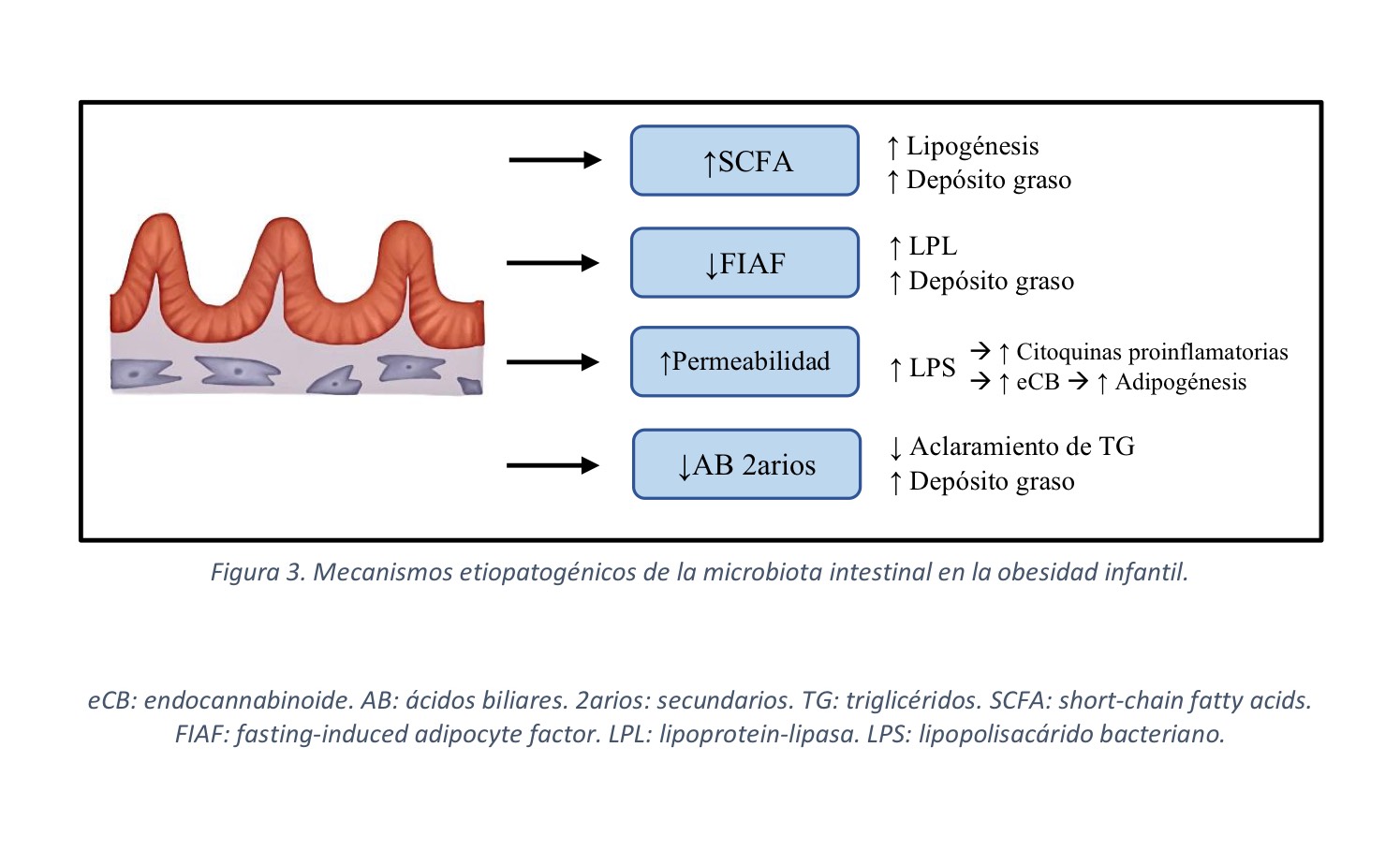Intestinal microbiota and childhood obesity: etiopathogenic and therapeutic implications
Main Article Content
Abstract
Background: Childhood obesity is presented as an increasingly prevalent disease in the 21st century. Nevertheless, this increment is not directly proportional to caloric intake or sedentarism. This matter has entailed initiating new investigations and situating the intestinal microbiota as a new risk factor for obesity in the early stages of life. Subject: A bibliographic review has been carried out through scientific literature research from 2013 to 2021. The medical databases PubMed, Scielo, Elsevier, and Cochrane have been used, thus obtaining 27 final articles. The cardinal difference between obese patients compared to normal-weight children is the increased Firmicutes/Bacteroidetes ratio. The intestinal microbiota intervenes in the pathogenesis of childhood obesity through five main mechanisms: modifications in bacterial composition, metabolite production, endocannabinoid tone increase, fasting-induced adipocyte factor expression decrease, and modulation of the gastrointestinal tract. Therapeutic strategies for treating childhood obesity through dysbiosis modification are prebiotics and probiotics administration, fecal microbiota transplantation, and physical exercise. Conclusions: As of today, the data still needs to be conclusive, given the scarcity of studies. It is necessary to carry out further experimental investigations and, once more concrete results are obtained, to implement clinical trials of the therapeutic options against specific bacterial groups.
Downloads
Article Details

This work is licensed under a Creative Commons Attribution-NonCommercial-NoDerivatives 4.0 International License.
Creative Commons
License Attribution-NonCommercial-ShareAlike 4.0 International (CC BY-NC-SA 4.0)
You are free to:
Share - copy and redistribute the material in any medium or format.
Adapt - remix, transform, and build upon the material The licensor cannot revoke these freedoms as long as you follow the license terms.
• Attribution — You must give appropriate credit, provide a link to the license, and indicate if changes were made. You may do so in any reasonable manner, but not in any way that suggests the licensor endorses you or your use.
• NonCommercial — You may not use the material for commercial purposes.
• ShareAlike — If you remix, transform, or build upon the material, you must distribute your contributions under the same license as the original.
• No additional restrictions — You may not apply legal terms or technological measures that legally restrict others from doing anything the license permits.
References
Martos-Moreno GÁ, Serra-Juhé C, Pérez-Jurado LA, Argente J. Aspectos genéticos de la obesidad. Revista Española Endocrinología Pediátrica. mayo de 2017;8(8 Suppl):21-32.
WHO. Obesity and overweight [Internet]. Obesity and overweight. 2021 [citado 3 de agosto de 2021]. Disponible en: https://www.who.int/news-room/fact-sheets/detail/obesity-and-overweight.
Tinahones FJ. La importancia de la microbiota en la obesidad. Rev Esp Endocrinol Pediatr. 2017;6.
Sanchez M, Panahi S, Tremblay A. Childhood Obesity: A Role for Gut Microbiota? International Journal of Environmental Research and Public Health. 2015;12(1):162. DOI: https://doi.org/10.3390/ijerph120100162
J. Klish W, A. Skelton J. Obesity in children and adolescents [Internet]. UpToDate. 2021 [citado 21 de marzo de 2022]. Disponible en: https://www.uptodate.com/contents/definition-epidemiology-and-etiology-of-obesity-in-children-and-adolescents#H10.
Bervoets L, Van Hoorenbeeck K, Kortleven I, Van Noten C, Hens N, Vael C, et al. Differences in gut microbiota composition between obese and lean children: a cross-sectional study. Gut Pathog. 2013;5:10. DOI: https://doi.org/10.1186/1757-4749-5-10
Castañeda Guillot C. Microbiota intestinal y obesidad en la infancia. Revista Cubana de Pediatría [Internet]. 2020 [citado 2 de agosto de 2021];92(1). Disponible en: http://scielo.sld.cu/scielo.php?script=sci_abstract&pid=S0034-75312020000100008&lng=es&nrm=iso&tlng=es.
Petraroli M, Castellone E, Patianna V, Esposito S. Gut Microbiota and Obesity in Adults and Children: The State of the Art. Front Pediatr. 19 de marzo de 2021;9:657020. DOI: https://doi.org/10.3389/fped.2021.657020
Mohammadkhah AI, Simpson EB, Patterson SG, Ferguson JF. Development of the Gut Microbiome in Children, and Lifetime Implications for Obesity and Cardiometabolic Disease. Children (Basel). 2018;5(12):160. DOI: https://doi.org/10.3390/children5120160
Márquez L, Abanades S, Andreu M. Sistema endocannabinoide e inflamación intestinal. Medicina Clínica. octubre de 2008;131(13):513-7. DOI: https://doi.org/10.1157/13127285
Yang YJ, Ni YH. Gut microbiota and pediatric obesity/non-alcoholic fatty liver disease. J Formos Med Assoc. 2019;118 Suppl 1:S55-61. DOI: https://doi.org/10.1016/j.jfma.2018.11.006
García de Paredes A, Rodríguez-de-Santiago E, Aguilera-Castro L, Ferre-Aracil C, López-Sanromán A. Trasplante de microbiota fecal. Gastroenterol Hepatol. 2015;38(3):123-34. DOI: https://doi.org/10.1016/j.gastrohep.2014.07.010
Leong KSW, Jayasinghe TN, Wilson BC, Derraik JGB, Albert BB, Chiavaroli V, et al. Effects of Fecal Microbiome Transfer in Adolescents With Obesity. JAMA Netw Open. 2020;3(12):e2030415. DOI: https://doi.org/10.1001/jamanetworkopen.2020.30415
Quiroga R, Nistal E, Estébanez B, Porras D, Juárez-Fernández M, Martínez-Flórez S, et al. Exercise training modulates the gut microbiota profile and impairs inflammatory signaling pathways in obese children. Exp Mol Med. 2020;52(7):1048-61. DOI: https://doi.org/10.1038/s12276-020-0459-0
Aragón-Vela J, Solis-Urra P, Ruiz-Ojeda FJ, Álvarez-Mercado AI, Olivares-Arancibia J, Plaza-Diaz J. Impact of Exercise on Gut Microbiota in Obesity. Nutrients. 2021;13(11):3999. DOI: https://doi.org/10.3390/nu13113999





